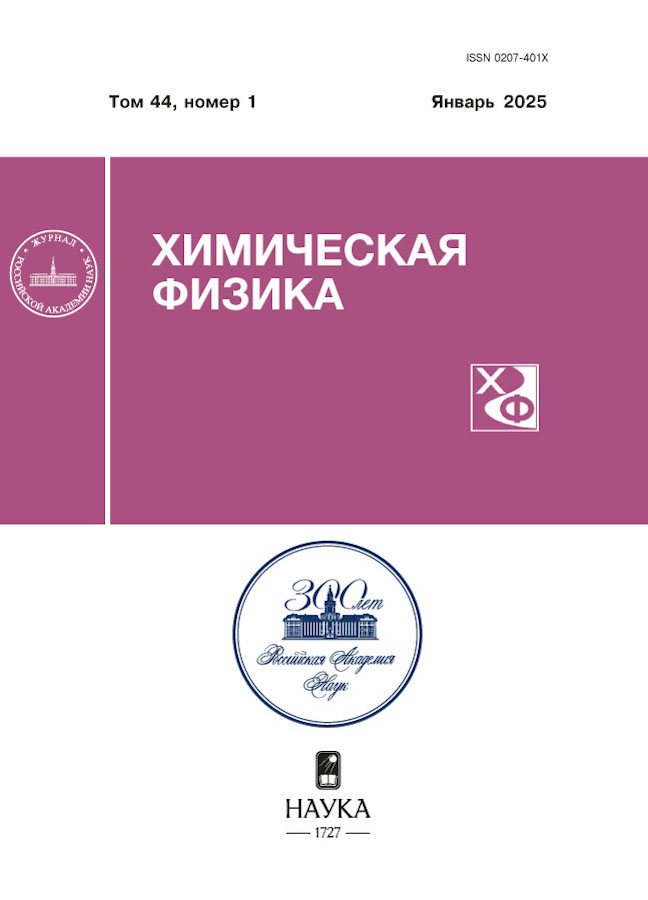Formation of ionic networks in molten salt mixtures. Computer experiment
- Autores: Galashev А.E.1,2
-
Afiliações:
- Institute of High Temperature Electrochemistry, Ural Branch of the Russian Academy of Science
- Ural Federal University named after the first President of Russia B.N. Yeltsin
- Edição: Volume 44, Nº 1 (2025)
- Páginas: 3-15
- Seção: Элементарные физико-химические процессы
- URL: https://permmedjournal.ru/0207-401X/article/view/683317
- DOI: https://doi.org/10.31857/S0207401X25010017
- ID: 683317
Citar
Texto integral
Resumo
Molten salts are used as heat-conducting media in liquid salt reactors and solar installations. Knowledge of the thermal conductivity of molten salt is necessary for the safe operation of these units. Computational methods are an alternative way to the hard-to-reach experimental way of determining thermal conductivity. In this work, the temperature dependence of the thermal conductivity of the molten salt FLiNaK, as well as this molten salt with NdF3 dissolved in it, was calculated using the method of equilibrium molecular dynamics. The temperature trend of thermal conductivity, as well as its change after the dissolution of NdF3 in FLiNaK, is explained based on the determination of the dynamic network of ionic bonds that exists in the molten salt model. Networks of ionic bonds were established with an upper limit of interionic distance of 0.2 nm for both types of salt melts and with a limit of 0.27 nm for the Nd–F network in a melt containing NdF3. These networks of bonds appear in different parts of the system over time and may disappear completely. The total number of dynamic network nodes, determined during the correlation of heat flows, has an impact on the thermal conductivity value of the simulated system. A new method for interpreting the temperature behavior of the thermal conductivity of molten salt in a computer model can be used for predictive purposes when fluorides of various lanthanides and actinides are dissolved in salt melts.
Palavras-chave
Texto integral
Sobre autores
А. Galashev
Institute of High Temperature Electrochemistry, Ural Branch of the Russian Academy of Science; Ural Federal University named after the first President of Russia B.N. Yeltsin
Autor responsável pela correspondência
Email: galashev@ihte.uran.ru
Rússia, Yekaterinburg; Yekaterinburg
Bibliografia
- C. Halliday, T.A. Hatton. Appl. Energy. 280, 116016 (2020). https://doi.org/10.1016/j.apenergy.2020.116016
- N. Sorbom, J. Ball, T.R. Palmer, F.J. Mangiarotti, J.M. Sierchio et al. Fusion Eng. Des. 100, 378 (2015). https://doi.org/10.1016/j.fusengdes.2015.07.008
- M.A. M. Akanda, D. Shin. J. Ener. Storage. 60, 106608 (2023). https://doi.org/10.1016/j.est.2023.106608
- L.N. Ignatieva, V.A. Mashchenko, O.M. Gorbenko, V.M. Bouznik. Rus. J. Phys. Chem. B. 17(6), 1330 (2023). https://doi.org/10.1134/S1990793123060039
- B.C. Froese. Adsorption of Neodymium Experiment Design to Simulate Nuclear Fuel Reprocessing. Syracuse: University Honors Program Capstone Projects, 2011, pp. 5–14. https://surface.syr.edu/honors_capstone/249
- Cervi, A. Lorenzi, A. Cammi, L. Luzzi. Chem. Eng. Sci. 193, 379 (2019). https://doi.org/10.1016/j.ces.2018.09.025
- V.M.B. Nunes, M.J.V. Lourenco, F.J.V. Santos, C.A. Nieto de Castro. J. Chem. Eng. Data 48.(3), 446 (2003). https://doi.org/10.1021/je020160l
- A.E. Gheribi, P. Chartrand, J. Chem. Phys. 144(8), 084506 (2016). https://doi.org/10.1063/1.4942197
- A.E. Gheribi, J.A. Torres, P. Chartrand. Sol. Energy Mater. Sol. Cells. 126, 11 (2014). https://doi.org/10.1016/j.solmat.2014.03.028
- R. G. Ross, P. Andersson, B. Sundqvist, G. Backstrom. Rep. Prog. Phys. 47(10), 1347 (1984). https://doi.org/10.1088/0034-4885/47/10/002
- R.R. Romatoski, L.W. Hu. Ann. Nucl. Energy. 109(2–3), 635 (2017). https://doi.org/10.1016/j.anucene.2017.05.036
- X.-H. An, J.-H. Cheng, H.-Q. Yin, L.-D. Xie, P. Zhang. Int. J. Heat Mass Transfer 90. 872 (2015). https://doi.org/10.1016/j.ijheatmasstransfer.2015.07.042
- S. G. Robertson, R. Wiser, W. Yang, D. Kang, S. Choi, E. Baglietto, M.P. Short. J. Appl. Phys. 131(22), 225102 (2022). https://doi.org/10.1063/5.0088059
- Y. Nagasaka, N. Nakazawa, A. Nagashima. Int. J. Thermophys. 13(4), 555 (1992). https://doi.org/10.1007/BF00501941
- G. Robertson, M.P. Short. Rev. Sci. Instrum. 92, 064905 (2021). https://doi.org/10.1063/5.0049727
- J.R.D. Copley, J.M. Rowe. Phys. Rev. Lett. 32(2), 49 (1974). https://doi.org/10.1103/PhysRevLett.32.49
- F. Demmel, S. Hosokawa, W.-C. Pilgrim. J. Phys.: Condens. Matter. 33(37), 375103 (2021). https://doi.org/10.1088/1361-648X/ac101c
- Hosokawa, F. Demmel, W.-C. Pilgrim, M. Inui, S. Tsutsui, A.Q.R. Baron. Electrochem. 77(8), 608 (2009). https://doi.org/10.5796/electrochemistry.77.608
- Bryk, I.M. Mryglod. J. Mol. Liquids. 120(1–3), 83 (2005). https://doi.org/10.1016/j.molliq.2004.07.041
- Kshevetskii, Y.A. Kurdyaeva, N.M. Gavrilov. Rus. J. Phys. Chem. B. 17(5), 1228 (2023). https://doi.org/10.1134/S1990793123050238
- M. P. Tosi, F. G. Fumi. J. Phys. Chem. Solids. 25(1), 45 (1964). https://doi.org/10.1016/0022-3697(64)90160-x
- D.J. Adams, I.R. McDonald. J. Phys. C: Solid State Phys. 7(16), 2761 (1974). https://doi.org/10.1088/0022-3719/7/16/009
- L. Pauling. J. Amer. Chem. Soc. 51(4), 1010 (1929). https://doi.org/10.1021/ja01379a006
- A.Y. Galashev, O.R. Rakhmanova, K.A. Abramova, K.P. Katin, M.M. Maslov et al. J. Phys. Chem. B. 127(5), 1197 (2023). https://doi.org/10.1021/acs.jpcb.2c06915
- J.E. Mayer, J. Chem. Phys. 1(4), 270 (1933). https://doi.org/10.1063/1.1749283
- H. Wang. Molecular Dynamics Simulations of Molten Salts: Force Field Evaluation and Development. Ph.D. Dissertation, Indiana: University of Notre Dame, Notre Dame, 2022.
- Y. Ishii, K. Sato, M. Salanne, P. A. Madden, N. Ohtori. J. Phys. Chem. B. 118(12), 3385 (2014). https://doi.org/10.1021/jp411781n
- E.I. Rudenko, N.V. Dohlikova, A.K. Gatin, S.Y. Sarvadiy, M.V. Grishin. Russ. J. Phys. Chem. B 17(4), 845 (2023). https://doi.org/10.1134/S1990793123040164
- B. Cordero, V. Gomes, A. Platero-Prats, M. Reves, J. Echeverria et al. Dalton Trans. 21(21), 2832 (2008). https://doi.org/10.1039/b801115j
- S. Thakur, C.J. Dionne, P. Karna, S.W. King, W. Lanford. Phys. Rev. Mater. 6, 094601 (2022). https://doi.org/10.1103/PhysRevMaterials.6.094601
- Rudenko, A. Redkin, E. Il’ina, S. Pershina et al. Materials. 15(16), 5603 (2022). https://doi.org/10.3390/ma15165603
- I.L. Braun, S.W. King, A. Giri, J. Gaskins, M. Sato et al. Appl. Phys. Lett. 109(19), 191905 (2016). https://doi.org/10.1063/1.4967309
- A.A. Voznyakovskii, A.P. Voznyakovskii, S.V. Kidalov, V.I. Zavarinsky. Rus. J. Phys. Chem. B. 15(3), 377 (2021). https://doi.org/10.1134/S1990793121030325
- R.L. Xu, M.M. Rojo, S.M. Islam, A. Sood, B. Vareskic. et al. J. Appl. Phys. 126(18), 185105 (2019). https://doi.org/10.1063/1.5097172
- A.Y. Galashev. Appl. Sci. 13(2), 1085 (2023). https://doi.org/10.3390/app13021085
- A.S. Özen, Z. Akdeniz. J. Mol. Liquids 368. Part B, 20771 (2022). https://doi.org/10.1016/j.molliq.2022.120771
- J. Li, H. Guo, H. Zhang, T. Li. Y. Gong, Chem. Phys. Lett. 718, 63 (2019). https://doi.org/10.1016/j.cplett.2019.01.035
- Bessada, D. Zanghi, M. Salanne, A. Gil-Martin, M. Gibilaro et al. J. Mol. Liquids. 307(2), 112927 (2020). https://doi.org/10.1016/j.molliq.2020.112927
Arquivos suplementares


















